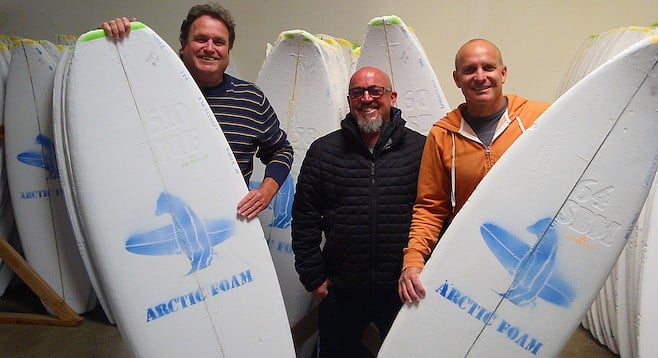 Facebook
Facebook
 X
X
 Instagram
Instagram
 TikTok
TikTok
 Youtube
Youtube

After 44 consecutive years in business, Gordon “Grubby” Clark, closed his doors for good. Clark’s company, Clark Foam, once produced most of America’s surfboard blanks, the foam cores essential to building surfboards.
His closure resulted in the surf industry panicking and scrambling to get blanks. Within two years, however, the industry had rebounded, and several companies began making foam. One of the tops among them is Arctic Foam.
The foam is produced in Ensenada and distrusted in Oceanside. According to Arctic co-founder Marty Gilchrist, “Before making surfboard foam, my partners Steve Mullen, Andrew Jakubowski and I were working for Rip Curl Wetsuits. After a while, we began having wetsuits made in Ensenada. By the time we became interested in making foam we knew a lot about doing business in Mexico and decided to have our foam made there.”
“Making foam is a lot like baking bread; there are so many variables that have to be just right. Everything from the right chemicals, the right temperature, the industrial crate paper needed for release, and the curing done in a giant steam room needs to come together.”
While surfers tend to be environmentally conscious, the materials they use are petroleum based and therefore highly polluting. According to Gilchrist, “About four years ago I read an article on algae and decided it could be the future of foam. Blanks made from algae oil are biodegradable, and algae replicate themselves every 24 hours.”
“Dr. Steven Mayfield from UCSD discovered a way to make a polyall, which is the basis of our foam, from algae oil. We got together with him and made some algae-based surfboards. On Earth Day three years ago we presented the first surfboard ever made from algae to Mayor Faulconer. We’re still working to perfect the formula, but we are now close to having the first algae-based surfboard foam on the market.”


After 44 consecutive years in business, Gordon “Grubby” Clark, closed his doors for good. Clark’s company, Clark Foam, once produced most of America’s surfboard blanks, the foam cores essential to building surfboards.
His closure resulted in the surf industry panicking and scrambling to get blanks. Within two years, however, the industry had rebounded, and several companies began making foam. One of the tops among them is Arctic Foam.
The foam is produced in Ensenada and distrusted in Oceanside. According to Arctic co-founder Marty Gilchrist, “Before making surfboard foam, my partners Steve Mullen, Andrew Jakubowski and I were working for Rip Curl Wetsuits. After a while, we began having wetsuits made in Ensenada. By the time we became interested in making foam we knew a lot about doing business in Mexico and decided to have our foam made there.”
“Making foam is a lot like baking bread; there are so many variables that have to be just right. Everything from the right chemicals, the right temperature, the industrial crate paper needed for release, and the curing done in a giant steam room needs to come together.”
While surfers tend to be environmentally conscious, the materials they use are petroleum based and therefore highly polluting. According to Gilchrist, “About four years ago I read an article on algae and decided it could be the future of foam. Blanks made from algae oil are biodegradable, and algae replicate themselves every 24 hours.”
“Dr. Steven Mayfield from UCSD discovered a way to make a polyall, which is the basis of our foam, from algae oil. We got together with him and made some algae-based surfboards. On Earth Day three years ago we presented the first surfboard ever made from algae to Mayor Faulconer. We’re still working to perfect the formula, but we are now close to having the first algae-based surfboard foam on the market.”
Comments